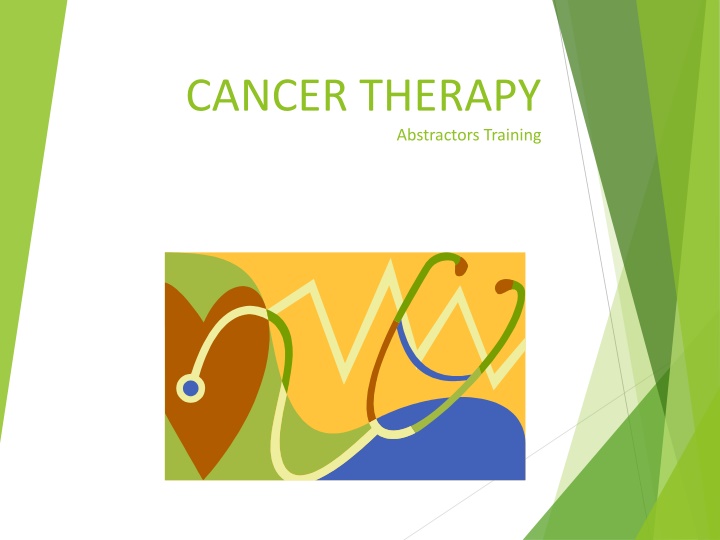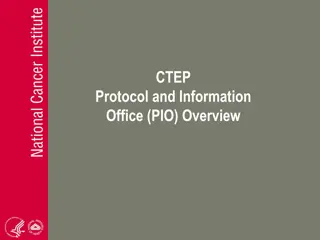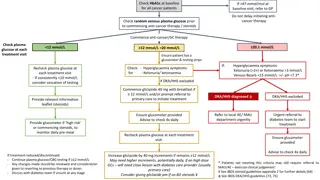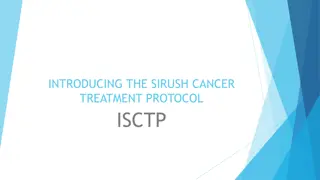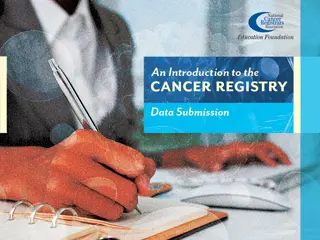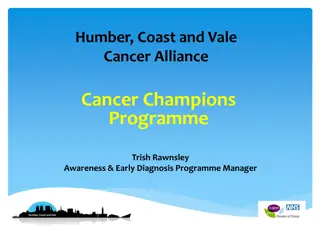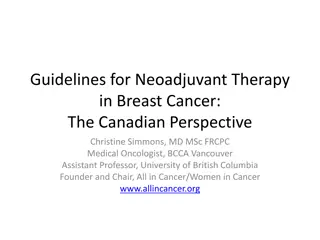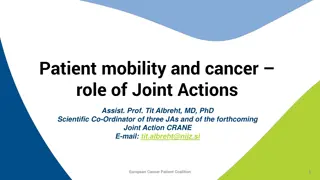CANCER THERAPY
Course details the types of cancer treatments, importance of documenting treatment plans, impact on research and patient outcomes, time period considerations, and guidance for initiating therapy without a formal plan or guidelines.
Download Presentation

Please find below an Image/Link to download the presentation.
The content on the website is provided AS IS for your information and personal use only. It may not be sold, licensed, or shared on other websites without obtaining consent from the author.If you encounter any issues during the download, it is possible that the publisher has removed the file from their server.
You are allowed to download the files provided on this website for personal or commercial use, subject to the condition that they are used lawfully. All files are the property of their respective owners.
The content on the website is provided AS IS for your information and personal use only. It may not be sold, licensed, or shared on other websites without obtaining consent from the author.
E N D
Presentation Transcript
CANCER THERAPY Abstractors Training
First Course of Therapy Treatment Plan Describes type(s) of treatment(s) intended to modify or control the malignancy Documentation confirming a treatment plan may be fragmented and frequently found in several different sources (Ex: medical record, clinic record, consultation reports, outpatient records) All cancer-directed treatments specified in the physician(s) treatment plan and delivered to the patient after initial diagnosis are First Course of Therapy Document treatment plan in text
Recording/Abstracting Cancer Therapy All Kentucky registries and registries that are part of ACoS-accredited cancer programs are required to record complete first course of therapy for analytic cases accessioned into CPDMS.net Complete reporting of first course of therapy is vital to researchers for determining treatment outcomes and developing more effective treatment and improving outcomes Complete reporting of first course of therapy impacts cancer patient survival
Time Period All malignancies except leukemia First course of therapy includes all cancer-directed treatment planned by the physician(s) during or after the first diagnosis of cancer Planned therapy may include multiple modes of therapy, and may encompass intervals of a year or more No treatment or active surveillance may be a planned treatment option, and is considered first course of therapy If a treatment plan is not available, evaluate the therapy and the time it started If the therapy is part of an established protocol or within accepted management guidelines for the disease, it is first course of therapy
Time Period (continued) Consult the attending physician (Ex: surgeon, medical oncologist, radiation oncologist) or your registry s physician advisor if protocols or management guidelines are not available If there is no treatment plan, established protocol or management guidelines, and you cannot consult with a physician, use the principle, first course of treatment must begin within four months of the date of initial diagnosis
Definitive Treatment Definitive treatment modifies, controls, removes, or destroys proliferating cancer tissue May be directed toward either the primary site or to metastatic sites Administered to minimize the size of the tumor or to delay the spread of disease NOTE: Only definitive therapy should be included in statistical analyses of treatment Surgery codes 00-07, and Other treatment code 0 are not considered definitive therapy and must be excluded from analyses
Palliative Treatment Palliative treatment improves the patient s quality of life by preventing or relieving suffering May include definitive treatment procedures as well as non- definitive patient care procedures (Ex: Patient diagnosed with stage IV colon cancer with extensive liver metastasis Patient is unresectable due to advanced stage of disease and advanced age - Begins chemotherapy intended to shrink the metastatic tumor and relieve symptoms The chemotherapy is palliative because shrank the tumors and relieved symptoms AND the chemotherapy is also definitive therapy because it destroyed proliferating cancer tissue) Record any palliative therapy that modifies or destroys cancer tissue if planned as part of first course definitive therapy
Non-Definitive Treatment Non-definitive treatment prolongs the patient s life, makes the patient comfortable, or prepares the patient for definitive therapy Not cancer-directed not meant to reduce the size of the tumor or delay the spread of disease Non-definitive procedures include diagnostic procedures and supportive care Generally not used in statistical analysis of treatment
Non-Definitive Treatment (continued) Examples of non-definitive treatment: Surgical procedures: Incisional biopsies Exploratory procedures with or without biopsies Supportive care/symptom relief: Pain medication Oxygen Antibiotics administered for an associated infection Transfusions* Intravenous therapy to maintain fluid or nutritional balance Laser therapy directed at relieving symptoms
Non-Definitive Treatment (continued) *NOTE: For many of the reportable hematopoietic diseases, the principle treatment is either supportive care, observation, or another type of treatment that does not meet the usual definition of treatment that modifies, controls, removes or destroys proliferating cancer tissue. Such treatments include phlebotomy, aspirin, supportive care and observation. These treatments are recorded as first course Other Treatment (code 1) for the hematopoietic diseases ONLY (as directed in the hematopoietic database and coding manual) Record a complete description of the treatment plan in the text field
Adjuvant vs Neo-adjuvant Therapy Definitive therapy (chemotherapy, radiation therapy, hormone therapy, immunotherapy, etc) given as part of planned first course of therapy after surgical resection is called adjuvant therapy. Definitive therapy (chemotherapy, radiation therapy, hormone therapy, immunotherapy, etc) given as part of planned first course of therapy before surgical resection is called neo-adjuvant therapy.
Treatment Status Summarizes whether patient received any treatment or was under active surveillance (watchful waiting) This field may be left blank for cases diagnosed prior to 1/1/10 Treatment administered after a period of active surveillance is considered subsequent therapy and is not coded in this item Definition: Code 0 =No treatment given Code 1 = Treatment given Code 2 = Active surveillance (watchful waiting) Code 3 = Unknown if treatment was given
Treatment Status (continued) Coding sample: 1. Patient diagnosed with prostate cancer and chooses to watch and wait . Treatment status code? 2. Patient diagnosed with colon cancer and undergoes a colectomy. Treatment status code?
Systemic Surgery Sequence Records sequencing of systemic therapy and surgical procedures given as part of first course of treatment Use this data field for cases diagnosed on or after 1/1/06 Codes: 0 = No systemic therapy and/or surgical procedures 2 = Systemic therapy before surgery 3 = Systemic therapy after surgery 4 = Systemic therapy both before and after surgery 5 = Intraoperative systemic therapy 6 = Intraoperative systemic therapy with other systemic therapy administered before or after surgery 9 = Sequence unknown
Radiation/Surgery Sequence Records the sequencing of radiation and surgical procedures given as part of first course of treatment Codes: 0 = No radiation therapy and/or surgical procedure 2 = Radiation therapy before surgery 3 = Radiation therapy after surgery 4 = Radiation therapy both before and after surgery 5 = Intraoperative radiation therapy 6 = Intraoperative radiation therapy with other therapy administered before or after surgery 9 = Sequence unknown
Reason No Non-Definitive Surgery Code reason no non-definitive surgical procedure performed as part of initial diagnostic work-up If non-definitive surgical specimen is diagnostic of malignancy, must create a non-definitive surgical therapy record for the earliest positive non-definitive surgical procedure For this field, record only biopsies that obtain tissue; fine needle aspirations that obtain only cells (not tissue) for cytology are not coded in this field
Reason No Non-Definitive Surgery (continued) Definitions of codes: 0 Non-definitive surgery not performed; not applicable; not recommended for this case; autopsy only 1 Non-defininve surgery performed and results diagnostic of malignancy 2 Non-definitive surgery performed and results negative for malignancy 3 Non-definitive surgery performed and results turned out to be definitive therapy (excisional biopsy) 8 No non-definitive surgery at this hospital; unknown if non-definitive surgery done elsewhere 9 Unknown if non-definitive surgery performed
Reason No Therapy Code reason why treatment not administered as part of first course of therapy Includes reason no surgery, no chemotherapy, no radiation therapy, no hormone therapy, no immunotherapy, no other therapy
Reason No Therapy (continued) Definition of codes 0 and 1 for surgery: Code 0 for surgery = Surgery was performed as part of planned first course of therapy Code 1 for surgery = Surgery was NOT performed as part of planned first course of therapy
Reason No Therapy (continued) Definition of codes 0 and 1 for chemotherapy, radiation therapy, hormone therapy, immunotherapy and other therapy: Code 0 for chemotherapy, radiation therapy, hormone therapy, immunotherapy and other therapy = not administered because it was not part of planned first course therapy Use code 0 when: There is no information in the patient s medical record about these therapies AND it is known that these therapies are not usually performed for this type and/or stage of cancer OR there is no reason to suspect that the patient would have undergone one of these therapies
Reason No Therapy (continued) If the treatment plan offered multiple treatment options and the patient selected treatment that did not include any of these therapies Patient elects to pursue no treatment following discussion of these treatments (a discussion does not equal a recommendation) Only information available is that the patient was referred to an oncologist (a referral does not equal a recommendation) Watchful waiting is the planned course of treatment Patient diagnosed at autopsy Code 1 for chemotherapy, radiation therapy, hormone therapy, immunotherapy and other therapy = Therapy administered as part of first course of therapy
Reason No Therapy (continued) Definitions of codes 2 9 for ALL therapies: Code 2 = Therapy not recommended/administered because it was contraindicated due to other patient risk factors (co-morbid conditions, advanced age, etc) Code 5 = Therapy not administered because patient died prior to planned or recommended therapy Code 6 = Therapy not administered; was recommended by patient s physician, but was not administered as part of first course of treatment no reason why noted in the medical record
Reason No Therapy (continued) Code 7 = Therapy not administered; was recommended by the patient s physician, but treatment was refused by patient, patient s family member, or patient s guardian refusal noted in the medical record Code 8 = Therapy recommended, but unknown whether it was administered Code 9 = Unknown if therapy recommended or administered, or death certificate case only* *The Kentucky Cancer Registry and the Commission on Cancer (for ACoS-accredited registries) recommend that you utilize all resources to obtain complete first course of therapy information. This may entail obtaining information from outside resources such as physician offices and other facilities. NCCN guidelines are a great resource for identifying usual treatment recommendations by primary site and stage of disease. NCCN guidelines can be found at www.nccn.org. The Hematopoietic Database is an excellent resource for identifying usual treatment recommendations for hematopoietic diseases. Consult the attending physician (Ex: surgeon, medical oncologist, radiation oncologist) or your registry s physician advisor if protocols or management guidelines are not available.
Reason No Therapy (continued) Coding sample: Patient undergoes an LAR (lower anterior resection) for for a rectosigmoid colon cancer. Reason no surgery code? 1. Patient is recommended by physician to undergo chemotherapy for colon cancer, but patient refuses. Reason no chemotherapy code? 2. Patient is diagnosed with rectal cancer at your facility and is discharged. No additional work-up performed at your facility (stage of disease unknown), no treatment at your facility, and no treatment plan documented, and unknown if treatment administered elsewhere. Reason no therapy code(s)? 3.
Reason No Therapy (continued) 4. Patient diagnosed with lymph node positive colon cancer and undergoes hemicolectomy at your facility. There is no information re: adjuvant therapy in the medical record. Per NCCN treatment guidelines, chemotherapy is recommended. Reason no therapy chemotherapy code?
Palliative Care Record the type of palliative care provided during the first course of planned therapy Given to relieve symptoms and may include surgery, radiation, systemic therapy or other pain management therapy Palliative procedures do not diagnose or stage the primary tumor Palliative surgical procedures, radiation therapy, and systemic therapy that are part of first course of therapy and that also remove or modify primary or secondary malignant tissue are coded in the palliative care fields AND in the respective therapy fields
Palliative Care (Continued) Codes: Code 0 = No palliative care provided; diagnosed at autopsy only Code 1 = Surgery (which may involve a bypass procedure) to alleviate symptoms, but no attempt to diagnose, stage, or treat the primary tumor is made Code 2 = Radiation therapy to alleviate symptoms, but no attempt to diagnose, stage or treat the primary tumor is made Code 3 = Chemotherapy, hormone therapy, or other systemic drugs to alleviate symptoms, but no attempt to diagnose, stage, or treat the primary tumor is made Code 4 = Patient received or referred for pain management therapy with no other palliative care
Palliative Care (Continued) Codes (continued): Code 5 = Any combination of codes 1, 2, and/or 3 WITHOUT code 4 Code 6 = Any combination of codes 1, 2, and/or 3 WITH code 4 Code 7 = Palliative care was performed or referred, but no information on the type of procedure available in the patient record; palliative care was provided that does not fit the descriptions in codes 1-6 (Ex: stent placement in bile duct for patient with pancreatic cancer)
Palliative Care (continued) Coding sample: 1. Patient diagnosed with advanced colon cancer undergoes colon bypass surgery with colostomy due to obstruction. Palliative care code? 2. Patient diagnosed with unresectable, obstructive colon cancer with extensive liver metastases and undergoes chemotherapy to hopefully reduce the tumor burden and relieve symptoms. Palliative care code?
End of Cancer Therapy Presentation Any questions? Lets complete the reason no therapy exercises. SS
